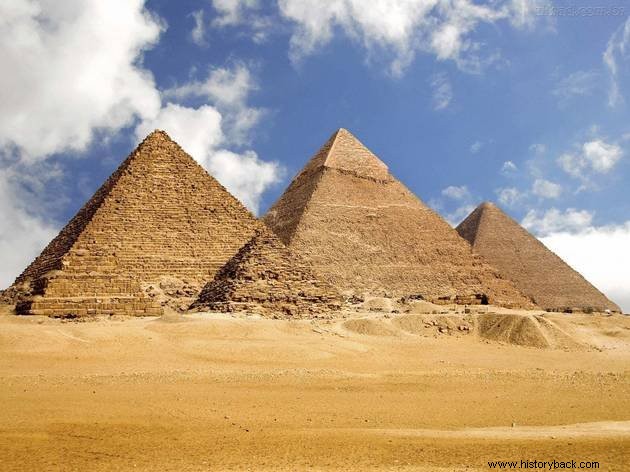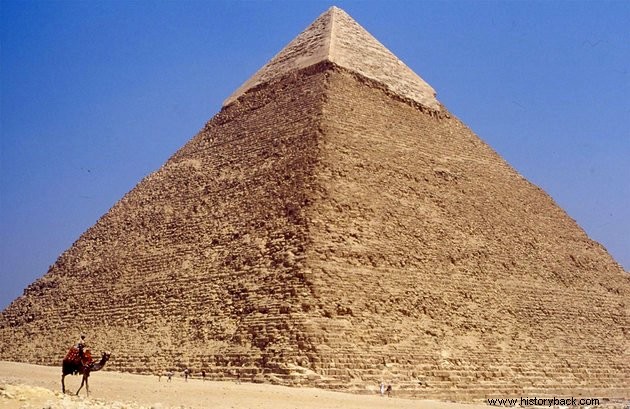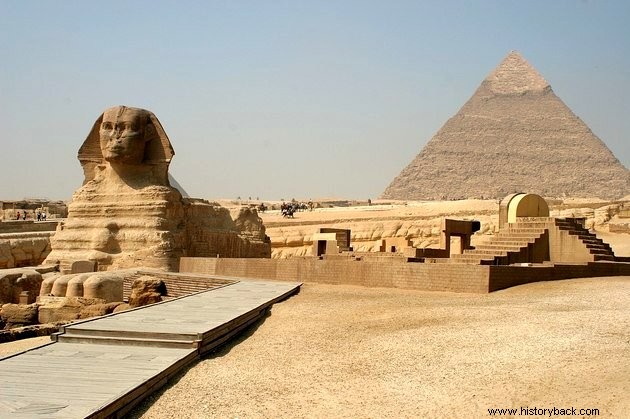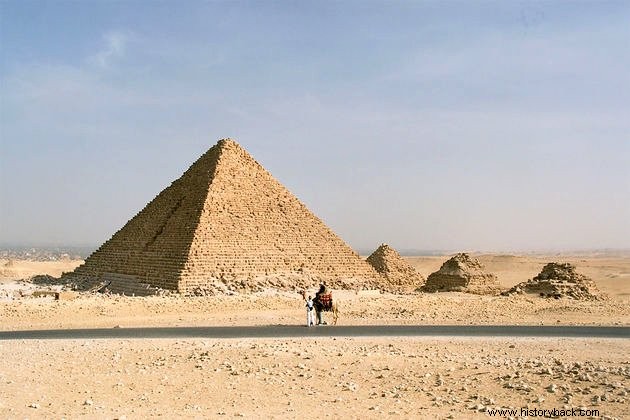The pyramids of Egypt they are tombs built in stone to house the bodies of the pharaohs.
There are 123 cataloged pyramids, however, the three best known are Cheops, Chephren and Menkaure on the Giza peninsula.
This architectural ensemble is guarded by the Sphinx, a mythological being with the body of a lion and the head of a pharaoh.
History of the Pyramids of Egypt

The pyramids were built at a time when a rich and powerful civilization was flourishing in Egypt.
Its construction began in the Old Kingdom (around 2686 to 2181 BC) and lasted until the 4th century AD, but the height of construction is recorded between the Third and Sixth Dynasties, around the year 2325 BC.
During this period, Egypt lived under political stability and economic prosperity. In turn, the pharaohs believed themselves to be a kind of deity chosen to be the mediators between gods and humans.
Therefore, after physical death, the Egyptians believed that the spirit of the king, which was known as Ka , remained in the body and required special care. Thus, their corpses were mummified.
In the mummification process, the pharaoh's body was carefully treated with oils and wrapped in bandages so that it would not suffer from the wear and tear of time. Some organs, such as the intestine and liver, were removed, but placed in special urns next to the sarcophagus.
In addition, the pharaoh was buried with everything he would need after death, such as his treasures, food, and even furniture. Relatives, priests and officials were also buried next to the pharaoh.
The First Pyramids
Until the beginning of the First Dynasty, 2950 BC, tombs were carved in rock or structures called "mastabas" were built. These were pyramidal in shape, but looked like squares stacked on top of each other and weren't that tall.
The first pyramid used as a mastaba model and was made around 2630 BC by King Djoser, who belonged to the Third Dynasty.
The Egyptians chose the pyramid shape to facilitate the pharaoh's ascension to the heavens, where he would be welcomed by Ra, the most powerful deity in Egyptian mythology.
This pyramid displays six stone steps that together add up to 62 meters in height. It was the tallest tomb at the time and was surrounded by shrines and temples for the sovereign Djoser to enjoy in his afterlife.
Djoser's pyramid set a benchmark for royal burials. Among the monarchs who lived long enough to coordinate the construction of their own tomb of the same dimensions was Sneferu, who lived between 2631 BC. and 2589 BC
See also:Ancient EgyptFeatures of the Pyramids of Egypt
The pyramids are named after the pharaohs whose bodies are buried inside. Each of them represents the greatness of the representative for the people and for the gods.
These buildings are part of a funerary complex that was used by pharaohs and high officials. The three most famous pyramids are Cheops, Chephren and Menkaure.
Shall we meet them?
Pyramid of Cheops

The pyramid of Cheops is the largest tomb in the world with 230 meters wide at the base and its height is 174 meters.
Three small pyramids were built in alignment with the tomb of Cheops and served to house the bodies of the queens. There is also a tomb with the sarcophagus of Queen Hetepheres, mother of Cheops, and other smaller pyramids and mastabas to house the king's officials.
The pyramid of Cheops is made up of 2.3 million stone blocks that weigh around 2.5 to 60 tons each. The construction work would have taken 20 years and had the strength of 100,000 men.
See also:PharaohPyramid of Khafre

The second largest pyramid on the Giza peninsula was built to house the body of Pharaoh Khafre, 143 meters high. Quefrén was the son of Pharaoh Queops and, out of respect for his father, made his pyramid 10 meters lower.
Next to it is the Sphinx of Giza, the largest in the ancient world, 200 meters long and 74 meters high.
See also:Sphinx of GizaPyramid of Menkaure

The smallest of this group of three pyramids was built for the body of Menkaure, who reigned between 2532 and 2503 BC, son of Khafre and therefore grandson of Cheops. It is 65 meters high and has a base of 105 meters.
Inside, the same architecture of chambers, steep corridors and false passages is repeated in order to fend off grave robbers.
Unfortunately, this provision did not help much, as practically all the treasures of the pyramids were looted.
See also:The Seven Wonders of the Ancient WorldEnd of the Age of Pyramid Building
As the power and wealth of Egypt's kings waned, the pace of pyramid building slowed. Throughout the Fifth and Sixth Dynasties, the buildings got smaller and smaller.
In the tomb of King Unas, who lived between 2375 and 2345 BC, you can see paintings relating to his reign. These are the first compositions that allow the knowledge of ancient Egypt.
The last of the great builders was Pharaoh Pepi II, second ruler of the Sixth Dynasty and who lived between 2278 and 2184 BC. After his death, Egypt collapsed, and only in the 12th Dynasty did the building of pyramids resume, but without the former grandeur.
See also:Egyptian CivilizationHow were the Pyramids of Egypt built?
The construction of the pyramids is among the greatest mysteries of engineering. It is known that the Egyptians made mathematical calculations based on their religious beliefs and this ended up determining the height and width of these buildings.
The workforce consisted of both slaves and free workers. Everything from enslaved foreigners to Egyptian peasants who worked during the Nile flood regime.
Likewise, countless artisans and painters were employed who manufactured the objects that would be placed to serve the pharaoh in the afterlife.
To transport the limestones that made up the pyramids, there are several theories. There are even those who believe that they were built with the help of extraterrestrials.
However, in late 2014, Dutch scientists put forward the last of the accepted hypotheses, which would involve using water to move the stone blocks.
The theory emerged from the observation of images of a person splashing water in front of what would be a sled on which a stone was seated, pulled by at least 150 workers.
The Egyptians also took advantage of the floods of the Nile River to transport the stones along its bed.
See also:Egyptian artFun facts about the Pyramids of Egypt
- The humblest people also wanted to share in the pharaoh's glory. So, in 2010, researchers discovered a ditch with 400 bodies of malnourished people near one of the pyramids.
- The expression "pharaonic work" comes from the constructions in Ancient Egypt and is related to the grandeur of the buildings.
- The pyramid of Cheops was the tallest building on the planet until the 14th century, when Lincoln Cathedral was built in England.
